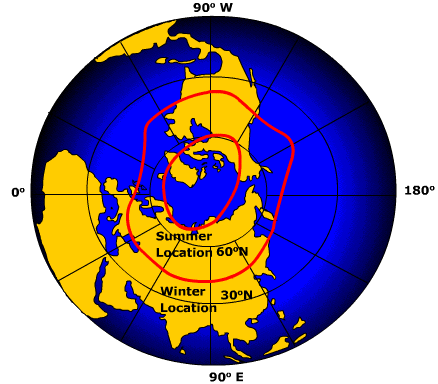FrontsFronts are boundaries between contrasting masses of air. Atmospheric scientists recognize fronts of different spatial scales. These range from the quasi-stationary fronts along which cyclones form to "weather" fronts embedded in cyclones. Fronts are three-dimensional features. They are not only a boundary between contrasting air masses running along the surface, but extend upwards into the troposphere as we will later learn. Quasi-stationary frontsAt the global scale are quasi-stationary fronts found migrating within a particular latitudinal zone throughout most of the year. The polar front is the boundary between polar-type air and tropical-type air. The polar front migrates between about 35o and 65o, following the annual cycle of earth surface heating (Figure 8.4). Above the polar front is found the polar front jet stream, a high velocity corridor of wind that controls the development and movement of mid-latitude cyclones.
Figure 8.4 Summer and winter location of the polar front During the winter, the polar front slides equatorward along with invading cold air. During the summer, the polar front retreats northward. This seasonal migratory pattern moves cyclones into and out of the middle latitudes giving them quite variable weather conditions over the seasons. |

